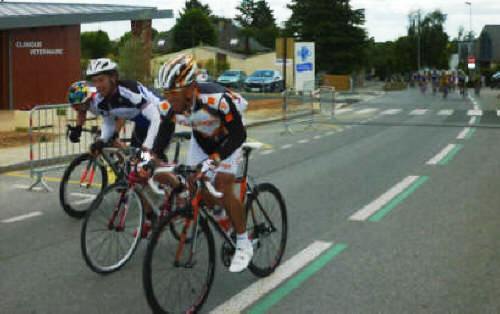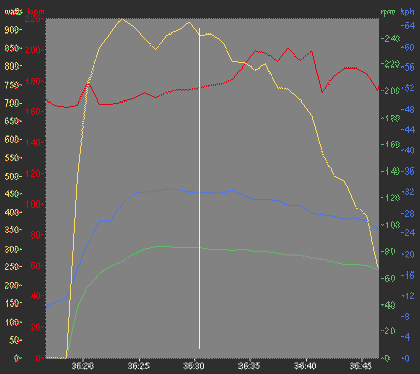30 Second SMINT's

These three riders have obviously done
their SMInts!
The bunch were all together at the base of the 500 metre climb
I'm coming up the far side (in the drops and out of the wind)...
La Marc Gomez Sportive
When & Why?
Supra-Maximal Intervals (SMInts) are best done once, possibly twice a week, in a four week
lead up to a key event. These intervals have the capacity to improve peak power output, along with aerobic and anaerobic performance, which make
up the majority of activity when we're pedalling our velocycles. SMInts will help you cruise at a more efficient rate, develop an explosive kick and sprint at a higher
intensity for a longer duration. A triple whammy, all for 30 seconds work;
it doesn't get any better.
Where?
The road is best for this session as it gives
a better feel and you can throw the bike around to get more bang for
your buck. It can be done on a turbo but you have to stay in the
saddle and, to me, it's not the same type of effort, feel or benefit.
Find a quiet road with a small climb, or gradual false flat. They give two different
returns on your efforts, so decide what you're trying to achieve.
The hill will build power, the false flat will build speed. Mix
and match to get the best of both worlds.
How?
Get the bike in the big ring and well down the block on the back;
start with a 53x14 and build up to a 13 and 12 as the weeks go by. Bring the bike to an almost full stop around 20 metres from the base of the climb.
Compose yourself and get "in the zone". Don't even think of attempting these half-heartedly, you'll tweak your back, damage a knee joint or just be wasting your time. Stand up, pull for all your worth on the bars as you push down on the pedals; get every last ounce of strength out of your body and in to the bike. Watch a track rider out of the gate and you'll get the idea of what's needed.
It will take four or five revs to get on top of the gear before you start building speed. As you get in the groove, you come off the flat and hit the bottom of the hill. The slope comes in to play and you've now got your own topographical resistance unit. You're now riding nature's very own Wingate Test.
Do everything you can to stay on top of the gear. You will physically feel the energy systems switch-over inside your body as the ATP-PC System (alactic anaerobic) exhausts and the Glycotic System (anaerobic glycolisis) kicks in as you hit the half-way mark. It really is a weird feeling if you're not used to it.
As you get to the end of the interval and (through necessity) sit down, your legs turn to jelly and all of a sudden you realise you are out of breath and your heart rate starts to go through the roof!
Take at least four and a half (preferably more), very, very, very easy minutes to recover before going again. Five is good, ten is the most you will ever get. If you can do more you're not doing them right.
Power File...

This is the power file for the video interval below.
Here's how it goes.
From an almost standing start (no revs, no power); Bang! Power
peaks, but isn't at our peak max because the revs are so low, so we're
measuring huge torque outputs as we press down for all we're worth.
The green revs build, torque (not shown) drops, yellow power flattens, then we hit the hill and the natural resistance that stresses our systems.
As we hit the slope the revs just slow their momentum (36:22), as we get back on top of the gear there's a little rise in power for the second peak (see shot below).
Ten seconds in (the white line) and the ATP-PC's gone, revs, power and speed are beginning to drop off as oxygen deficit (listen to the breathing on the video), lactate, pain and heart rate all begin to rise. The end is very near.
Screen Shot...

At seven seconds in, from an almost standing start, we're at 838 watts, having peaked on this occasion at 930 watts. Heart rate is 162, before peaking at 199 bpm. way after the power had collapsed; although on the video, right at the end, as we come off the corner, you'll see 202 bpm. That's a 40 beat increase in thirty seconds.
Use these sessions sparingly and use them as a top up session during the season. When you've got your endurance and you've got your race speed nailed, these intervals can just make that half-percent difference that turn you in to a winner.
I also fire a 10 second cut down version in to my pre-event warm up sessions. Just two or three, well spaced apart, get the systems primed for the mayhem to come. Do them on the flat and as soon as you get on top of the gear, stop pedalling and coast. You'll be doing around 50 kph on a good day!
Let me know how you get on!
Video Channel...
And here's what it looks like in real life...
The Warm Up & Usage Warning
All interval sessions require a thorough and
proper warm up...
When you first do them, start at slow walking pace to protect your back, knees and elbows in case you fall off! As you get better, or more confident, bring the bike to a complete standstill.
The really big gears need to have the bike just crawling forward to protect your back and knees.
If you have any weakness in the back or knees DO NOT attempt these intervals! I think I've laboured the point now, so no complaining emails please...
These intervals can be incorporated in to a normal road ride if you want to get the best of both worlds; intensity and endurance. Just don't attempt any hills after you've done them.








